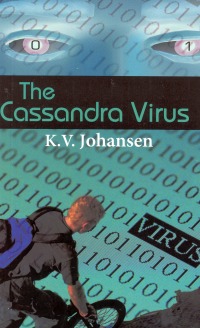| ________________
CM . . .
. Volume XII Number 13 . . . .March 3, 2006
excerpt:
Thirteen-year-old Jordan O’Blenis is a computer genius. Against the advice of his best friend and confidant, Helen, he decides to create a “supercomputer” which functions much like a virus. He names this program Cassandra, after his equally genius, older sister, Cassie. Cassandra uses other people’s computers via the Internet and is able to access private files, emails, satellites and much more. Unlike other programs that merely analyze data, Cassandra gains the ability to “think”. Dr. Ruggles, vice-president of Muddphaug University, (where Cassie is a graduate student and Helen’s mother a professor), overhears Jordan and his sister discussing Cassandra. He sells this information to the government. Soon Jordan’s life is upside-down as agents from the mysterious “Bureau 6” attempt to steal his program. In The Cassandra Virus, author K.V. Johansen presents the fascinating, yet frightening concept of a living computer while confronting the reader with ethical dilemmas, such as, abuse of power, invasion of privacy and theft of intellectual property. The text is packed with computer-related terminology that adds to its integrity; however, some of this vocabulary may not be easily accessible to junior readers. The characters, their dialogue and actions, are, for the most part, credible, though one might be hard-pressed to find a 13-year-old boy today who will stick out his tongue at someone, not once, but three times in one day. The Cassandra Virus is an exciting premise, but the pace of the novel is slowed by lengthy sentences that are long-winded, and, though grammatically sound, interrupt the flow of the narrative. For example:
An author’s note at the back of the book indicates the novel takes place in the near future. This note may have been helpful to have at the start for there are not enough obvious signs to indicate the story takes place in a time other than the present. Although the publisher recommends this novel for 9-12 year-olds, this reviewer feels that, despite the main character’s age, the font size, physical appearance of the book, long chapters, vocabulary and sentence structure better suit an audience in the 12-15 range. Recommended. Marina Cohen has a Master’s Degree in Literature from the University of Toronto and has been teaching in the York Region District School Board for 10 years.
To comment
on this title or this review, send mail to cm@umanitoba.ca.
Copyright © the Manitoba Library Association. Reproduction for personal
use is permitted only if this copyright notice is maintained. Any
other reproduction is prohibited without permission.
NEXT REVIEW |
TABLE OF CONTENTS FOR THIS ISSUE
- March 3, 2006.
AUTHORS |
TITLES |
MEDIA REVIEWS |
PROFILES |
BACK ISSUES |
SEARCH |
CMARCHIVE |
HOME |
